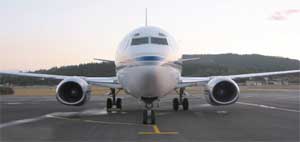
News
On the Fly-December 03
Industry news including an interview with Ken Wilson, president of Wilson Aircraft
October 1, 2007 By Fred Petrie
 Canada’s first VIP B737 ready to roll Canada wil account for 25% of business
Canada’s first VIP B737 ready to roll Canada wil account for 25% of business
Pacific
Sky Charter has finally received a type certificate for Canada’s first
VIPconfigured Boeing 737 aircraft. Based in Victoria, the operator will
launch executive charter services in the first quarter of 2004. Pacific
Sky also operates an eightpassenger Cessna Conquest II turboprop. And
while the Canadian market is expected to bring in approximately 25% of
business, the sweet spot will be the US west coast.
“An aircraft
of this size is unusual for the west coast,” said Mike Orr, Pacific
Sky’s chief financial officer. “Most aircraft of a similar size are
based in the east.” This market advantage should give Pacific Sky
plenty of room to manoeuvre, with an aircraft that offers luxury
seating for 23 passengers (including a stateroom with ensuite lavatory
and shower), and the flexibility to slip in and out of smaller
airfields.
The service is aimed at senior executives who require
a larger aircraft for longdistance travel. In-flight amenities are
provided by career professionals such as an executive chef and
experienced butler who have since been trained to work in an aircraft
environment. “We are selling not just the hardware, but the service
that comes with it,” Orr told WINGS during an onboard breakfast at
Orlando’s Executive Airport. The aircraft leases for US$10,000 an hour,
and Orr estimates the breakeven point to be 250 flying hours annually.
The
Boeing 737 series 500 was purchased by Pacific Sky from a private
Middle East owner in 2001. What should have taken between six weeks and
90 days to certify has dragged on for two years.
As frustrating
as the delay has been, it has given Pacific Sky time to refine the
inflight product and market the service globally, with promotional
stops in Asia, Dubai, EBACE and this year’s Canadian Business Aviation
Association show in Calgary. Orr acknowledges that showcasing the
aircraft and making the business case to potential customers in advance
of certification has been expensive, but necessary. “The people who
attend these shows are our potential customers. What does it say about
us if we don’t show up?”
Private sector to boost CC-130 availability 50% Capacity squeezed by age and skills shortage
Defence
Minister John McCallum wants to boost the availability of Canada’s
ageing fleet of Hercules transports by 50%, and will call on
private-sector MROs to help. The minister recently told the Ottawa Sun
that it was time to “think creatively outside the box” when it came to
keeping the Canadian Forces’ fleet of 32 Hercules airborne. The
military has already cut the maximum flying time for the fleet from
21,000 hours to 16,200 – a cap that would have stripped 1,700 hours
from last year’s mission profile.
The planned 3.5% reduction in
CC-130 availability is intended to reduce wear on the aircraft. But
wear is not the only problem. Military technicians are already spread
thin and Canadian Forces does not have the personnel readily available
to service a fleet that requires increased maintenance time. As a
result, only 13 aircraft were available last year at any given time.
McCallum is confident that by contracting out maintenance to the
private sector, Canadian Forces can have up to 21 Hercules aircraft
available. Even so, it is unlikely Canada will be able to push the life
cycle of several of its oldest aircraft beyond 2010.
Take 5 with Ken Wilson
The president of Wilson Aircraft talks to David Carr about his 35 years in aircraft sales.
1. You’ve been a pilot since 1961. What lured you into sales?
I
was sitting at the old Brampton Flying Club doing part-time flight
instruction when Jim Waters, who is no longer with us, was delivering a
new Cessna 150 trainer. A light bulb went on. I was a salesman and I
was a pilot – maybe I could combine them both.
2. Have you flown every model you have sold?
I
was not checked out on the Falcon aircraft in the mid-seventies, but I
did handle the controls of the Falcon 10 for a few minutes. So, yes, I
have flown every model I have sold, other than the Falcons.
3. Has the approach to aircraft sales changed in 35 years?
The
major manufacturers are not supporting learning to fly or the use of
business airplanes when conducting business. In the seventies the major
manufacturers were part of a team to promote learning to fly in a more
aggressive manner than what has been going on in the last 15 years.
4. What distinguishes this market downturn from previous ones?
Throughout
North America we are seeing more and more business people driving if
they’ve got a trip up to 500 miles where, prior to 9/11, they thought
nothing of hopping on a commuter airplane like the Cessna Caravan to
see customers.
5. Do you sense an uptick in the market for the Caravan?
I
do, but it’s not a big uptick – yet. It is still difficult to convince
people who won’t listen that the single-engine turbine is safe. That
attitude is gradually changing. Throughout all businesses, we are
learning how to do more with less. The Caravan is made for that kind of
thinking.